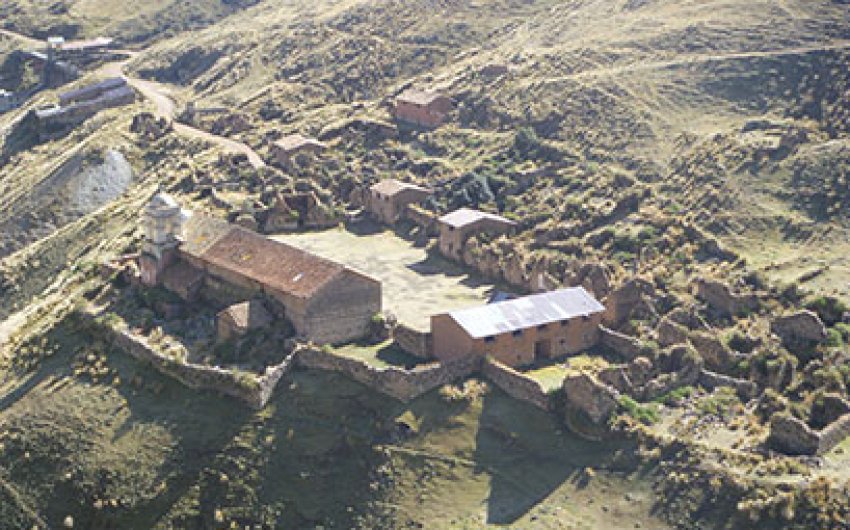
High in the Peruvian Andes, in the southeastern region of Huancavelica, lies a brown, treeless mountaintop — the scars of the now-boarded-up Santa Bárbara mercury mine. The mine was once the epicentre of mercury production in the Spanish colonial empire, and its legacy is social and environmental devastation.
Spanish colonisers learned the location of rich deposits of cinnabar — which is heated to yield mercury — in the late 1500s, and quickly realised their importance to the colonial economy.
The colonisers had developed a new refining technique, using mercury, which allowed them to extract silver from lower-quality ore. Having exhausted many of the rich silver deposits in their colonial mines, the Spanish needed mercury to process lower-grade ore into silver.
The use of Spanish silver coins as a global currency allowed for trade between countries and drove the accumulation of capital in the expanding colonial empires of Britain, Portugal, Holland and China. The mercury exploited from the mine in Huancavelica therefore played a crucial role in feeding emerging imperial economies.
University professor Nicholas Robins provides a detailed account of the social and environmental impacts of the mine on the region in his 2017 book, Santa Bárbara’s Legacy: An Environmental History of Huancavelica, Peru.
“The city’s history is inseparable from that of modern capitalism,” writes Robins, “as the quicksilver [mercury] which flowed from it was the vital ingredient which allowed Andeans to produce quantities of silver which enabled the development of the world’s first sustained global trade network, spurred the Industrial Revolution, and yielded today’s global economy.”
“Much of the silver exported from South America during the colonial and early national periods would not have been released from its ore were it not for Huancavelica’s mercury.”
The colonisers established the town of Villa Rica de Oropesa (now called Huancavelica) a mere 2.5 kilometres from Santa Bárbara to support mining operations and provide a place to refine the cinnabar ore.
Viceroy of Peru Francisco de Toledo — a cruel Spanish aristocrat acting at the behest of the crown — implemented a forced labour system where Indigenous people from communities up to hundreds of kilometres away were captured, chained and sent to the mine. Many died on the arduous marches to mine, from exhaustion, lack of food and the freezing conditions.
The brutal labour and unsafe working conditions imposed by the colonisers condemned thousands of Indigenous people to death or lifelong illness. Life expectancy once a worker was sent into the mine was usually about two years, their life likely claimed by mercury poisoning, silicosis or a mine collapse.
The physical and psychological symptoms of mercury poisoning, known by workers as the “evil of Huancavelica”, included uncontrollable tremors, weight loss, mouth ulcers, breathing problems, psychosis, depression and obsessive-compulsive disorders.
By the 1600s, Santa Bárbara was known as “la mina de la muerte”, or “the mine of death”. Many parents resorted to crippling their children to spare them the death-sentence of working in the mine.
Despite the untold deaths and suffering, the Spanish continued operating the mine until Peruvian independence in the early 1800s. After surveying working conditions at the Santa Bárbara mine in 1616–19, Spanish lawyer Juan de Solórzano reported back to the king: “The poison penetrated to the very marrow, debilitating all the members and causing a constant shaking, and the workers usually died within four years.”
But King Phillip IV ordered that mining continue, a decree also maintained by his successor Charles II.
The land around the mine was cleared extensively to provide construction materials and fuel for the smelters, writes Robins.
After Peruvian independence, mining operations continued at a reduced scale.
Nevertheless, several thousand tonnes of mercury-laden waste poisoned the surrounding land and waterways for centuries until the mine’s closure in the 1970s.
Today, mercury vapour emanates from the soil, unpaved roads and even the walls of houses built from mercury-contaminated adobe (mudbricks).
Huancavelica is “one of the world’s most mercury-contaminated urban areas”, writes Robins.
A 2015 study by the Environmental Health Council of houses built from adobe found that 75% had mercury contamination exceeding safe levels. The study estimated that at least 19,000 people were exposed to unsafe mercury levels and therefore at risk of developing associated health problems.
The Ichu River, which runs through the city, was found to be heavily contaminated by mercury, lead and arsenic.
Long-term mercury exposure, even in small amounts, can cause health problems such as kidney failure, loss of hearing and vision, anaemia, memory loss, cognitive impairment, loss of motor control and insomnia.
Pregnant women and babies are particularly vulnerable, as mercury can be passed on to a foetus in the womb and through breast milk. High levels of mercury in pregnant mothers can cause stillbirths and neurological problems from birth, and impair physical and mental development.
Huancavelica resident María* told Green Left that the mine’s impacts are still seen today, in the city’s high rates of anaemia and stillbirths.
María said that although the Santa Bárbara mine is now closed, smaller-scale mining still happens nearby. “What kind of authority approves that?”
Huancavelica, being in one of Peru’s poorest regions with a high Indigenous population, has been largely ignored by the government. The high rates of extreme poverty and chronic malnutrition (the highest in the country) compound the problem — poor general health makes the body more susceptible to the negative impacts of mercury exposure.
The Peruvian government has failed to respond to the urgent need for remediation, despite the grave health problems facing thousands of people.
In December last year, Huancavelica’s High Court of Justice ordered the federal Council of Ministers to declare an environmental emergency in the city and the nearby community of Sacsamarca due to heavy metals pollution, which reflects a process started by local communities in 2021.
Local communities are still waiting for the federal government to respond.
[*María is not her real name.]